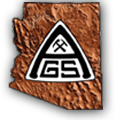

|
| 
Nirio Mendoza Inca, Colorado School of Mines, Geology and Hydrothermal Alteration of Red Mountain Lithocap, Eastern Lake City Caldera, Hinsdale County, Colorado, U.S.A. (59 minutes)
Long-time AGS member Richard (Dick) Jones has recently submitted a paper on Laterite-Hosted Gold Deposits. This interesting article can be viewed at this link.
Mark Holland, Ph.D. Arizona Geological Survey, The Ghost of Sutures Past: A Re-evaluation of the Yavapai-Mazatzal Province Boundary in Central Arizona (59 minutes)
Brian Gootee and Tawnya Wilson, Arizona's Deep Subsurface: Exploring energy Resiliency through Gas Storage, Mineral-Sequestration, and Geothermal Energy. This 65 minute presentation include 10-minutes of Q&A.
Steve Reynolds, Ph.D., “Untangling the stratigraphy of the upper Paleozoic Supai and Naco Groups of the Mogollon Escarpment,” recorded 3 Dec. 2024. The 67-minute presentation includes 20-minutes of Q&A
Critical and strategic minerals have been buzzy terms in the news in the last few years, but have an often-ignored history that stretches clearly back to World War I. Critical mineral topics have been receiving bipartisan support from Congress as sourcing them addresses multiple needs. For one, in the United States, we are dependent on imports of critical minerals from other countries to meet 50% to 100% of total domestic demand for almost all critical minerals. Thus, many of these supply chains are vulnerable to disruption from geopolitics, social upheaval, and other unexpected events. Additionally, the renewable (or green) energy transition away from fossil fuels to reduce carbon footprints and combat climate change will require huge amounts of metals compared to current levels. There are simply not enough active mines or emerging deposits of many of the critical minerals to meet projected global demand. This talk will: 1) sift through the jargon around critical and strategic minerals and materials; 2) provide a survey of the history of critical and strategic minerals in the United States; 3) an overview of the known critical mineral deposits in Arizona with primary critical mineral ores and those with potential to produce byproduct critical mineral ores; and 4) future demand scenarios and how the United States could work to meet these demands.
Field Trip Participants at Discovery Outcrop of Cactus (Sacaton) Deposit The recent field trip to visit the Santa Cruz and Cactus (Sacaton) porphyry copper deposits of the Casa Grande area was a great success. AGS Executive Committee thanks Ralph Stegan for organizing the trip and the staffs of the Ivanhoe Electric and Arizona Sonoran Copper Company for providing tours of their deposits. An excellent field guide, which can be viewed at this link.
Big Sandy Field Trip Participants examining an outcrop on Big Sandy Field Trip (photo by Brian Gootee) The recent Big Sandy Field Trip was a great success. AGS Executive Committee thanks Paul Jensen for organizing the trip and the staff of the Arizona Geological Survey - Brian Gootee, Carson Richardson, Lisa Thompson, Brad Johnson & Phil Pearthree - for leading trip and providing and excellent field guide, which can be viewed at this link.
Stankeithite (Mn2Te4+4O10) A Tellurite from Moctezuma Mine, Sonora Mexico Stankeithite, a newly discovered mineral is named after long-time AGS member Stan Keith. Stan is a consulting geologist and founder of MagmaChem.
Copies of both hardback and paperback versions of this publication can be purchased from Amazon.com.
Rasmussenite, a newly discovered mineral is named after long-time AGS member Dr. Jan Rasmussen. Jan is a consulting geologist and a former professor at Pima Community College.
Rasmussenite IMA No. 2024-018 Ca(C2H3O3)2 3H2O (glycolate subgroup) - White sprays and spherules of fibers in fractures in leucogranite - a micromount mineral from Pusch Ridge, Santa Catalina Mountains, north of Tucson, Pima County, Arizona, USA, by Hexiong Yang, Xiangping Gu, Anthony R. Kampf, Warren Lazar, Ronald B. Gibbs, and Robert T. Downs.
Articles contained within the Arizona Geological Society Digests 1 through 22 are now available on-line at our publications page. Our out-of-print Digests are available to the public, While our in-print Digests are only accessible to AGS members. Anyone who is interested in purchasing Printed Copies of In-Print AGS Digests can do so on-line or contact the AGS Secretary for more details. Copies of current AGS Guidebooks and Digests are also for sale at a reduced price at AGS monthly dinner meetings. |
|
|
||
|




























.png)














